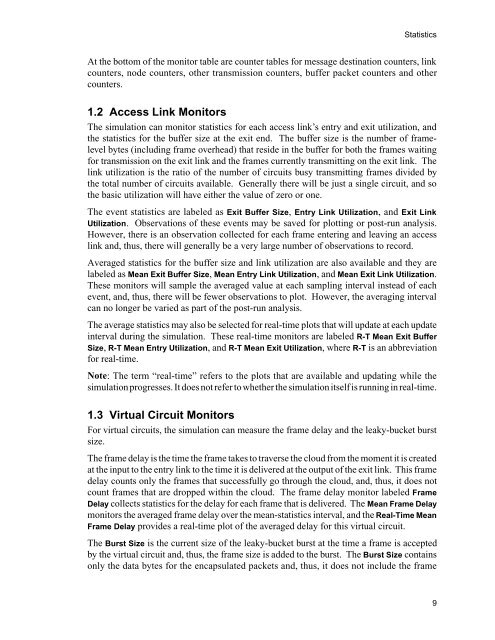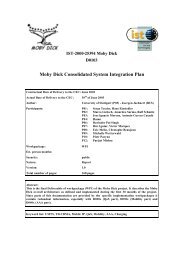COMNET III
COMNET III
COMNET III
You also want an ePaper? Increase the reach of your titles
YUMPU automatically turns print PDFs into web optimized ePapers that Google loves.
Statistics<br />
At the bottom of the monitor table are counter tables for message destination counters, link<br />
counters, node counters, other transmission counters, buffer packet counters and other<br />
counters.<br />
1.2 Access Link Monitors<br />
The simulation can monitor statistics for each access link’s entry and exit utilization, and<br />
the statistics for the buffer size at the exit end. The buffer size is the number of framelevel<br />
bytes (including frame overhead) that reside in the buffer for both the frames waiting<br />
for transmission on the exit link and the frames currently transmitting on the exit link. The<br />
link utilization is the ratio of the number of circuits busy transmitting frames divided by<br />
the total number of circuits available. Generally there will be just a single circuit, and so<br />
the basic utilization will have either the value of zero or one.<br />
The event statistics are labeled as Exit Buffer Size, Entry Link Utilization, and Exit Link<br />
Utilization. Observations of these events may be saved for plotting or post-run analysis.<br />
However, there is an observation collected for each frame entering and leaving an access<br />
link and, thus, there will generally be a very large number of observations to record.<br />
Averaged statistics for the buffer size and link utilization are also available and they are<br />
labeled as Mean Exit Buffer Size, Mean Entry Link Utilization, and Mean Exit Link Utilization.<br />
These monitors will sample the averaged value at each sampling interval instead of each<br />
event, and, thus, there will be fewer observations to plot. However, the averaging interval<br />
can no longer be varied as part of the post-run analysis.<br />
The average statistics may also be selected for real-time plots that will update at each update<br />
interval during the simulation. These real-time monitors are labeled R-T Mean Exit Buffer<br />
Size, R-T Mean Entry Utilization, and R-T Mean Exit Utilization, where R-T is an abbreviation<br />
for real-time.<br />
Note: The term “real-time” refers to the plots that are available and updating while the<br />
simulation progresses. It does not refer to whether the simulation itself is running in real-time.<br />
1.3 Virtual Circuit Monitors<br />
For virtual circuits, the simulation can measure the frame delay and the leaky-bucket burst<br />
size.<br />
The frame delay is the time the frame takes to traverse the cloud from the moment it is created<br />
at the input to the entry link to the time it is delivered at the output of the exit link. This frame<br />
delay counts only the frames that successfully go through the cloud, and, thus, it does not<br />
count frames that are dropped within the cloud. The frame delay monitor labeled Frame<br />
Delay collects statistics for the delay for each frame that is delivered. The Mean Frame Delay<br />
monitors the averaged frame delay over the mean-statistics interval, and the Real-Time Mean<br />
Frame Delay provides a real-time plot of the averaged delay for this virtual circuit.<br />
The Burst Size is the current size of the leaky-bucket burst at the time a frame is accepted<br />
by the virtual circuit and, thus, the frame size is added to the burst. The Burst Size contains<br />
only the data bytes for the encapsulated packets and, thus, it does not include the frame<br />
9
















